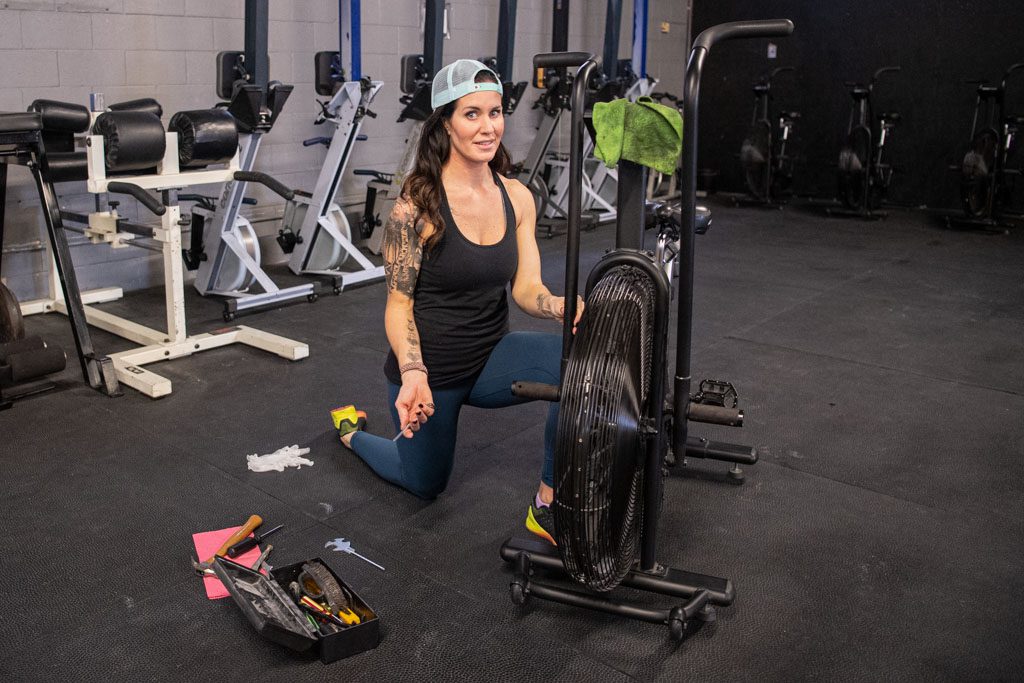I recently bought a treadmill.
I took the advice of other people like me online. I don’t know them, but they do the same sports I do, so their recommendations were worth a $3,000 purchase.
On Tuesday, I received a shipping notification from the treadmill company.
On Wednesday, I got a little email showing me how to unbox the treadmill, how to set it up and how to start out.
On Thursday, I got one more email: some tips to start (and stick with) a walking program—because most treadmill buyers are first-time exercisers.
I used to sell treadmills for a living. I know that most treadmills turn into clothes racks within a month and garage-sale items within a year. I know that the industry was front-loaded: People bought one treadmill in their life, and the transaction ended there.
But home fitness equipment companies have new opportunities. They can sell ongoing subscriptions to training plans or online classes or games like Zwift, Aaptiv, Mirror, Tonal, Hydrow … and they can call it “coaching.”
But we can turn it around on them.
First: The Tools You Need
When I found online scheduling software in 2005, it was a huge epiphany: We could throw out our messy day planners and let clients choose their own appointments. No more no-shows or last-minute cancellations. And then, in 2006, we found MindBody, which tied payments to bookings! Hallelujah: no more awkward “you owe money” talks with clients!
But since then, software tools in the fitness industry have morphed into slow “scoreboards” with appointment tracking and payments tacked on as an afterthought. (There are a few good ones bucking the trend—read our detailed report here.) But what do gym owners really need to run a business?
I think it’s:
- A client relationship management (CRM) platform to track clients and leads (we like UpLaunch).
- An appointment scheduler that integrates with payment processing.
- Something to track client results and show their progress.
By the end of next year, you’ll need:
- A way to deliver programming to clients who aren’t in the gym and have them track their progress.
- A better camera and microphone.
- A nutrition program for everyone you coach.
- A fluency in tools available to you outside your gym.
In our report on coaching software, we found that Trainerize has a lot of this covered. It’s not perfect, but it’s probably the best option for personal trainers, and maybe the best choice for gym owners, too. At least for now: Several others were close.
But the tools don’t make the coach. Tools should extend and scale your care, not replace it. In the end, your success will be determined by the personal care you extend, not the emails you automate.
And new tools give you the opportunity to extend that care into new markets. Below, I’ll tell you how to see these tools as opportunities instead of competition.
Second: The Tools You Don’t Need
Many gyms sign up for things they don’t need and then fail to use them.
Then, when they do an expense audit, they add up what they’ve spent and regret the purchases.
Here’s what you shouldn’t spend your money on in 2020:
- Marketing agencies that will “do it for you.” Every marketing agency is incentivized to increase ad spend. They’re a lot like mutual fund salespeople: As the market gets worse, they tell you to spend more. It has a ratchet effect that costs you more and more for fewer results. And without skin in the game, marketing agencies really never have to get creative with their own money. Learn to do it yourself, teach a staff person, and continually track and improve your funnel instead.
- Coaching courses that teach something beyond the scope of fitness. Partner with local health-care professionals instead. Read “Scope of Practice” here.
- Equipment or education you can’t tie directly to more revenue. Too many box owners are over-educated and poor. Plan to upgrade your coaching education in 2021 and your business education in 2020.
Third: The New Opportunities
Online spin classes, Zwift, remote trainers—they aren’t your competition. They’re a breeding ground for your next clients.
Every time a spin bike company sells a monthly “coaching” subscription, it’s doing you a favour. The company is teaching its clients the value of coaching.
You don’t have to do that part anymore. All you have to do is reach those people and tell them that you’re the next step.
Now, I’ve screwed this up. When I brought CrossFit to our city, I thought I was competing with P90X. Remember that? A bunch of DVDs that people followed for eight weeks.
A couple of firefighters told me “I don’t need to do CrossFit. I can do P90X at home!” so I thought I was in a life-or-death battle with the program.
What I should have said was, “That’s great! I hear good things. When you get bored, give me a call.” And then I should have called them eight weeks later—because everyone got bored with P90X. They would have been ready for CrossFit. I could have said, “You’ve taken Step 1! Here’s Step 2.”
People sign up for at-home coaching programs for many reasons. One is that they’re scared to exercise in front of other people. They think, “I’ll get started at home and then join a gym.” But if you tell them that’s dumb (like I did), they’ll just stay in their basement. If you pit yourself against the treadmill company, you’re also pitting yourself against its user.
Not-so-Obvious On-Ramps
Here’s another story: I used to publicly denounce laparoscopic surgery. I thought our government was crazy to subsidize “the easy way out.” I thought people were wasting their time having their stomachs cinched off with rubber bands. I thought they should exercise instead.
One day, as I was working up a good rant about it to a couple of clients, one of them touched me on the arm to interrupt.
“Chris,” she said kindly, “I’ve had the surgery.”
I was shocked: “You, Cathy? I don’t believe it!”
Cathy was one of our most hardcore CrossFitters at the time. She followed every blog, watched every video. She’d usually be the one to fill me in on the CrossFit Games gossip.
But she’d had stomach-reduction surgery. And she changed my viewpoint with what she said next:
“I needed to feel good about myself before I could join a gym.”
Laparoscopic surgery wasn’t my enemy. It was my on-ramp!
Peloton isn’t your enemy. It’s your on-ramp!
Bowflex isn’t your enemy. Strava and Zwift aren’t your enemies. Orangetheory isn’t your enemy. They’re all on-ramps to your service!
Instead of “us, not them,” we should be saying, “Would you like a bit more?”
Leveraging the New Tools
Think about online coaching the way you’d think about a library.
“Here is all of the information you’ll ever need organized in one place.”
But nobody learns how to do open-heart surgery at the library. No one quits smoking after reading a book about it. And no one reads the same book every day. Eventually, people need a teacher. And then they need a coach.
If I wanted to attract local cyclists to my gym (and I do, because I am one of them!), I would start by posting my own rides on Strava.
In my Strava profile, I’d post a link to a local group ride. I’d create the ride if none existed.
At the group ride, I’d mention how much my climbing speed had improved since adding front squats.
Then I’d say, “Hey, all of you guys keep asking me about front squats. Tell you what: Let’s just start the ride from my gym next week, and I’ll show you what I mean.”
And then I’d book 1:1 appointments with each person who showed up.
People seek out groups of others like them. The key to marketing is “finding the others.” The key to sales is showing “the others” how you can help them.
I searched for “Peloton” on Facebook and found dozens of open groups and forums. Here were a few categories:

What if I told you that the next 20 clients for your gym were waiting in those groups? Would you dive in and grab those gold coins?
How to Take Action in 2020
Forget about ads: Start 20 new conversations next year. (Actually, run your ads, too—and retarget the new audiences you create through these conversations. Your ad spend will go down and your conversions will increase.)
Write love letters to the people in these groups.
Talk to them on video. Record a podcast—whatever. Show them you care and how you can help them.
If I had an Orangetheory franchise next door, I’d be happy. Orangetheory is great at taking average people who are scared of intense exercise and introducing them to our world.
Over time, the thing these people once considered “extreme” becomes normalized in their brains. And then it’s easier to introduce something that’s just a little … bit … harder. Instead of taking them from a zero to a 9 on the “things I’m willing to do to lose weight” scale, we can allow Orangetheory to take them from zero to six and then accept the baton.
Microgym owners who open next to globo gyms are also very smart: People can try to exercise on their own and then add coaching when the results slow down.
Turning these potential competitors into new opportunities doesn’t require a pivot in your business model. It doesn’t require a rebrand. It requires a new perspective. That’s really what a mentor is for.
Other Articles in This Series
State of the Fitness Industry: 2019
State of the Fitness Industry: Your Brand
State of the Fitness Industry: The Disappearing Middle
State of the Fitness Industry: Rebirth

